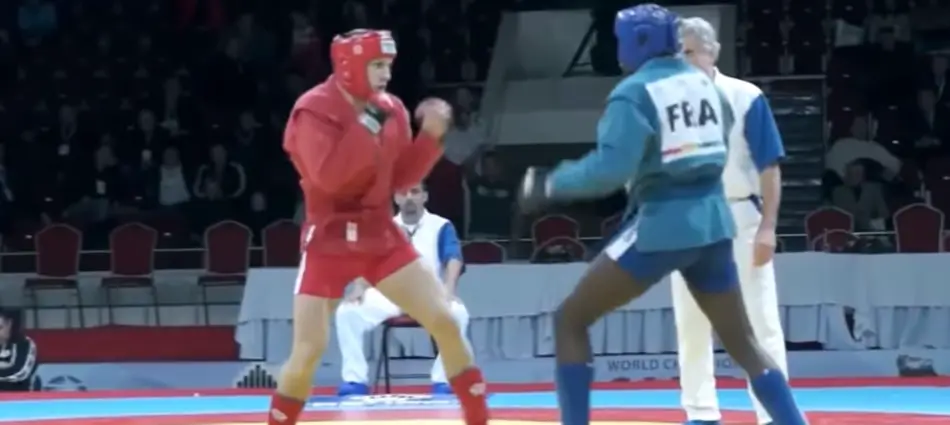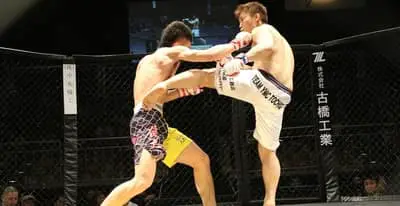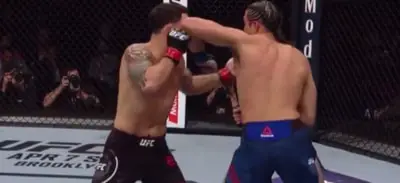
This is my list of the best martial arts for self-defense that you can use effectively after 6 months or less of training.
There are two scores for each martial art – Difficulty and Effectiveness. I ordered them by both of those scores but the difficulty factor has a slight priority because the focus of this article is on the easiest martial arts you can learn. The easiest martial arts are on in my list.
So let’s get started with number 1:
1. Boxing
Difficulty: 3/10
Effectiveness: 6.5/10
Boxing is by far the easiest martial art to learn. In boxing, you use only your hands to punch and your feet to just move around and not strike like in kickboxing/Muay Thai/MMA/Karate, etc.
Boxing stance is up-right, with slightly bent knees which is super easy, unlike for example the crouching wrestling stance which can be super exhaustive for most people.
Everybody can practice boxing. As long as you can make a fist, you’re just fine. Basic boxing doesn’t require much athleticism, like strength, power, speed, or flexibility.
Don’t get me wrong, boxing is a super hard and grueling sport. Things such as speed, endurance, power, timing, precision, or attributes like long reach and good chin are super important for competitive boxing. But now we’re talking just about self-defense against untrained people.
Even if you aren’t a great athlete, you can still defend yourself pretty effectively using basic boxing skills. That’s why boxing has a difficulty score of just 3/10 on my list.
Effectiveness:
I love basic boxing. For a “streetfight” against someone with no fighting skills, you’re just fine with only 2 punches – the jab and the straight right.
The jab is the simplest yet the most effective punch you could ever throw. It’s super rangy and easy to throw because it doesn’t cost a lot of energy. But you can win streetlights or even boxing matches just with your jab.
It’s several times more dangerous without gloves. Noone would like a hard bare-knuckle jab to the nose. Most people with no fighting experience will quit just after 1-2 of those jabs. The coolest thing is that you can learn to throw a decent jab for self-defense in about two weeks if you practice it every day.
The other super important punch is the straight right (or left if you’re a southpaw). That’s the rangiest punch you can throw and one of the most powerful ones. Most people throw hooks when they fight, which you can easily eat with straight punches which are rangier, quicker, and less telegraphed.
Another cool thing about boxing is that in the right circumstances it could be used against multiple attackers. That something you can’t do with grappling martial arts.
To use boxing effectively, besides punching you’ll also need to know basic boxing footwork, defense, and understanding of distance but if you train regularly you can learn those things on a basic level for less than 6 months.
It can be super frustrating at first thoug, especially things like foot pivoting when puching, footwork and headmovement. But the “frustrating period” in boxing is no more than 4-6 weeks if you train 3 times a week. This is much less compared to other martial arts on the list.
The drawbacks of boxing a self-defense sport is mostly the lack of grappling and even clinching. Boxers aren’t allowed to fight in a clinch, which is a position that occurs in 80% of the streetfights. That’s why, although it can be great for self-defense, the score of boxing when it comes to effectiveness is 6.5.
2. BJJ
Difficulty: 6.5/10
Effectiveness: 8.5/10
BJJ is hands down the best martial art for 1 on 1 combat. Even MMA fighters use mostly BJJ in such situations.
The focus on BJJ is to finish the fight by submitting the opponent using chokeholds, or joint manipulations (armbars, kimuras, leg locks, neck cranks, etc). That makes BJJ the ultimate self-defense martial art.
Although it’s one of the more gentle sports on the list, because of the chokeholds we can say that this is the deadliest sport ever.
The problem with BJJ for most beginners is that it isn’t an intuitive sport at all. When watching boxing or kickboxing, we pretty much know what is happening even if we never practiced those sports. But that’s not the case with BJJ.
At first, you won’t have an idea of what it’s going on while rolling. You’ll have to spend additional time watching videos on the basics of BJJ like the basic positions, techniques, and submissions.
I call the frustration period, the time you need to spend doing certain sport to get good enough to have fun while practicing it. The reason why most people quit is that they don’t train regularly enough to get quickly to pass that period.
In boxing the frustration period can be less than a month if you do shadowboxing every day, even 5-10 minutes are enough.
In BJJ, though that period is much longer. One reason for that is the unique movements and techniques you need to learn. The other one is rolling. Most likely you’ll get tapped out by 90% of the people in your first 3-5 months.
That will make you feel that you suck, while in reality, you have great progress. I remember training for like 4-5 months before starting getting good and started fiding specific techniques that work for me and using them effectively. Before then I was tapped in 8/10 of the times.
That’s why I gave BJJ 6.5/10 in terms of difficulty.
Effectiveness:
What I like about BJJ is that it helps smaller people handle bigger untrained opponents with relative ease on the ground which is great for self-defense. Untrained people have no chance on the ground against a skilled BJJ fighter.
I remember how helpless and fragile I felt when rolled for the first time. But slowly BJJ gave me great confidence when it comes to ground fighting.
The techniques you learn in BJJ are either defensive techniques, submission attacks, or positions of control of the opponent. Gi BJJ (with kimono) can teach you how to use the clothes of your opponents to control them or even choke them out. And those are super important things for self-defense.
That’s why I recommend training both Gi and No-Gi BJJ. For example, if you train 4 times a week, do 3 times the one you like more and 1 time the other one.
BJJ has an 8.5/10 effectiveness score on my list a not 10/10 because there’s no striking in BJJ, no ground-and-pound. Also, BJJ practitioners usually don’t spend enough time practicing takedowns and that’s because the main focus of BJJ is ground fighting. However, almost all fights start on the feet and you should be able to take people down with ease.
3. Muay Thai
Difficulty: 5.5/10
Effectiveness: 8/10
Muay Thai is the ultimate striking martial art according to many people. What I really like about Muay Thai is that it has all different kinds of strikes – punches, kicks, knees, and elbows. Another cool thing is clinching. Muay Thai is the best sport to learn to clinch.
Muay Thai fighters use the clinch to land elbows and knees, to control the opponent by breaking his posture and to sweep or trip the opponent. Clinching is one of the most important skills you need for self-defense in my opinion.
Most of the fights end up in a clinch so you need to be able to defend yourself from strikes in the clinch and stop takedowns.
When it comes to difficulty, Muay Thai isn’t that easy. The punches and the footwork are almost the same as in boxing but the kicks are harder to learn in require a bit more flexability and balance.
Also when practicing Muay Thai you’ll need good coordination and timing with your legs, not only to throw kicks but also to block kicks. You’ll need several months and a lot of patience to do that, that’s why the difficulty score of Muay Thai is 5.5/10.
Effectiveness:
Muay Thai is great for self-defense because it has techniques for all striking ranges – kicking range, log to mid boxing range and clinching range.
The mose effective techniques from Muay Thai you can use for self-defense are the elbows in the clinch and the leg kicks from a distance. Muay Thai practitioners have a the best leg kicks. Not only because of their technique which is awesome but also because kicking the headvy bag regularly makes their bones denser.
If you get kicked in the leg just one time by a good leg kicker and you never experienced that before, that can destroy your legs and you’ll feel the pain as you walk for a few days.
Most people won’t expect to attack their legs in a street fight since most people throw punches or start grapple when fighting. That’s why I believe leg kicks are an awesome weapon you can use for self-defense.
Based on all of that I give Muay Thai 8/10 score in terms of effectiveness. The only thing Muay Thai lacks is ground fighting and submissions which are crutial for a street fight.
Also in Muay Thai kicks give you more points than punches, which makes it a kicking heavy sport. That’s great because punishing the body or the legs of an untrained person using kicks can make him quit pretty quickly but if your kick gets caught you can get taken down. And on the ground, you’ll need different skills to win.
4. Kickboxing
Difficulty: 5/10
Effectiveness: 7.5/10
Kickboxing (or dutch kickboxing) is a combination between boxing, Muay Thai with some techniques from traditional martial arts like Taekwondo.
The differences between kickboxing and Muay Thai in terms of rules are that there’s almost no clinching in kickboxing (clinching rules are similar to boxing) and the rules of most kickboxing tournaments forbid using elbows.
When it comes to the actual fighting, kickboxers use much more boxing combinations than Muay Thai fighters who often throw just 1-2 strikes at a time. Kickboxers always try to finish their combinations with a kick whether it’s to the body or the head and their footwork is a little more sophisticated than the footwork of Muay Thai fighters who are often seen as more stationery.
Besides roundhouse kicks, kickboxers also use techniques from taekwondo such as spinning back kicks, wheel kicks, ax kicks, or sidekicks. Muay Thai fighters prefer using just front kicks (or teeps) and roundhouse kicks. All those techniques can be effective in various situations.
Since kickboxing is similar to Muay Thai but there’s no clinching I give 5/10 difficlty score of that martial art.
Effectiveness:
What I like about kickboxing more than Muay Thai is its focus on boxing combinations. They can be supper effective for self-defense.
What I don’t like is the lack of clinch work and elbow strikes. That’s why the overall score of kickboxing for effectiveness is 7.5/10.
5. Sanda
Difficulty: 6.5/10
Effectiveness: 8/10
Sanda is a Chinese military martial art. It’s full-contact striking sport judo throws and even takedowns by grabbing the legs are allowed too. The sport is very similar to Muay Thai with little differences in the allowed techniques.
That makes sanda fighters more well-rounded than kickboxers and boxers. But there is no ground fighting or elbows to the head allowed which as I mentioned I think can be very useful weapons for self-defense.
In the fights I’ve watched, I noticed that some Sanda fighters have good boxing combinations mixed with taekwondo like footwork – linear bouncy footwork.
Because of the mix between striking and grappling/wrestling I give Sanda a 7/10 difficulty score. The main problem with sanda is that it” not a very popular sport outside of China and it’s hard to find sanda school although is great martial art.
6. Judo
Difficulty: 6/10
Effectiveness: 5/10
Judo was designed to be the ultuimate grappling martial art. In Judo there are throws and takedowns as well as ground fighting and submissions.
But with the evolution of the sport, it became clear that you can focus on both ground fighting and stand-up grappling (takedowns/throws) and be good at both.
That’s why the main focus of Judo today is the throws. Judo throws are awesome and they are used in other combat sports such as sambo and sanda as well as MMA and wrestling. With the leverage the proper technique gives you, you can slam much bigger untrained people relatively easy.
Judo throws are also great for self-defense because they are designed to throw the opponent with a decent force on the ground while you remain standing. You can use a quick throw to take down the attacker without following him to the ground and then run out of the danger.
On the ground, Judo teaches you good control positions such as side control and mount and also submissions such as armbars and chokeholds.
The drawbacks of judo are that there’s no striking and also you need to make some adjustments to make your throws work No-Gi since judokas wear kimonos and use them to get grins when performing throws.
In a self-defense scenario that can be a problem because not every time the attacker will be wearing a jacket which you can grab to throw him.
Also the Judo ground game is not as nearly good as the BJJ ground game and submissions.
7. Combat Sambo
Difficulty: 8.5/10
Effectiveness: 9/10
Combat sambo is a Russian military martial art and it’s the closest sport to MMA. The only differences are that the competitors are wearing Gi jackets, there’s no cage and some point and rules differences.
However, combat sambo focuses on takedowns and more specifically judo throws which as we discussed are super effective in a street fight.
In combat sambo, all kinds of strikes are allowed – punches, kicks, elbows knees, and even headbutts. All of that combined with judo throws, wrestling takedowns, submissions (chokeholds, kimuras, armbars, leg locks) and ground-and-pound makes it an awesome sport for self-defense.
You can argue even that combat sambo is better for street fighting than MMA. That’s because combat sambo matches are only 5 min (unlike the long 15-25 min MMA matches) and the goal is to finish the fight as quickly as possible – the same goal when defending yourself.
The only unrealistic thing about combat sambo is that besides knockout and submission you can finish the fight and win by performing a perfect throw which is throwing the opponent on his back while you remain standing.
That’s why I give comabt sambo 9/10 Effectiveness score.
When it comes to difficulty, the ground game of sambo fighters isn’t as sophisticated as BJJ or MMA fighters and their striking isn’t as polish. The main focus is the throws and takedowns. That’s why the difficulty score of Combat sambo is 8.5/10.
8. MMA
Difficulty: 10/10
Effectiveness: 10/10
MMA isn’t a martial art single martial art. MMA fighters use all kinds of techniques from other martial arts as long as those techniques are effective. And that, by definition makes it the most effective martial art out there.
When it comes to fighting or self-defense, there’s no better sport than MMA.
However, all the different styles and techniques make MMA tricky to learn. You’ll have to spend time doing boxing, kickboxing, wrestling, and grappling. That will take at least 6 months of hard work to get to a decent level to be able to defend yourself in some situations.
But the time you spend training MMA would be definitely worth it! If you want some tips on how to speed up the process check out my article 7 Tips for Starting MMA with no Martial Art experience.
9. Wrestling
Difficulty: 10/10
Effectiveness: 8/10
Wrestlers are one of the best athletes in the world. They are strong, fast and have a good endurance. In terms of technique, freestyle wrestling is the best sport for takedowns, controling and scrabling.
As a martial art wrestling is one of the most important ones. If you look at MMA, right now 7 of 8 of the UFC champs came from a wrestling background. They don’t always use wrestling to win but the athleticism, endurance, strengths, and grit wrestling gave them definitely help.
To be a good wrestler though, you have to start at a young age. There aren’t wrestling classes for adults in most places and you need years of practice to execute the techniques effectively. You can still learn some basics of wrestling if you practice BJJ, MMA, or Judo/Sambo but it won’t be the same.
Few people become good at wrestling by starting late or practicing other grappling martial arts.
Also, wrestling requires athleticism, flexibility, strength and speed, and endurance. I remember when I first started wrestling I was coming from a BJJ and boxing background and I thought I had decent cardio since I could do a lot of rounds in boxing and I can roll a lot without getting tired.
Boy, I was wrong! After 3 2-minute rounds of wrestling with a bigger guy, I felt as exhausted as never before! Wrestling is a super grueling sport and it’s probably the hardest of all combat sports. Because of that and the factors I mentioned earlier, I give wrestling a 10/10 difficulty score.
Effectiveness:
The ability to take somebody down and control them can safe you in many self-defense situations. The good news is that you don’t have to be a great wrestler to do that against regular, untrained people.
As I mentioned, wrestling classes for adults aren’t a thing in most cities but you can learn good enough takedowns for self-defense if you train BJJ but focus on stand-up grappling and wrestling.
The drawbacks of wrestling are that there are no striking nor submissions. You will have to learn some basic BJJ submissions like rear-naked choke, guillotine, or kimura to be able to finish fights.
The only thing wrestlers have on the ground is the ground-and-pound. Even though they don’t practice it, it’s not that hard to use once you establish a dominant position.
The lack of striking can be a problem because in some situations you want to keep the fight standing and avoid the ground fight. For example, if you get attacked by multiple attackers. Because of that, the Effectiveness score of wrestling for self-defense is 8/10.
10. Karate
Difficulty: 4/10
Effectiveness: 3.5/10
Karate is one the last spot on my list not because it’s super hard, it’s actually quite fun from the get-go, but because it’s not very effective for self-defense.
That’s not the martial arts’ fault, karate is actually super cool. But there are tons of karate gyms where noone is doing full-contact sparring which leads to practicing uneffective techniques.
Once karate was one of the best striking martial arts but nowadays it’s just not the best option if you want to effectively defend yourself especially if we are talking about 6 or fewer months of training.



